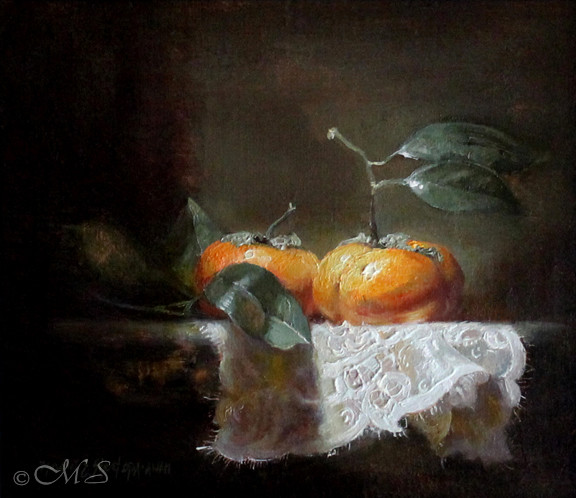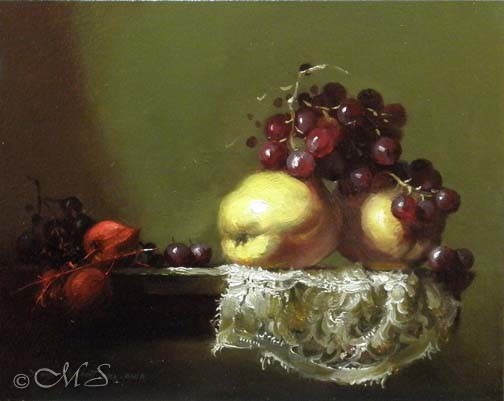Compelling and interesting shadow shapes are one very critical component to creating excitement in your oil painting compositions.
Light, light direction, light diminishing and building, and light falling on objects can be used to the fullest and will portray drama and mystery depending on how you use it in each particular place on your composition. I feel most comfortable starting from the left and slowly proceeding towards the right. This is the way we read – left to right – and the mind readily follows this path.
The light begins dimly and slowly graduates to a crescendo of brightness as it moves across my composition. Within that concept is the natural way certain objects such as leaves or flowers block the light and create interesting shadow shapes that gracefully fall across other objects. Without this, a composition can be very bland.

© Margret E. Short 2016
In Panoply, the light gradually moves from left to right building to a brightness in the focal area. The shadow created by the leaf in front of the first persimmon adds a dimension of drama. It is a perfect opportunity to create mystery within that shadow shape using blurred edges, giving the viewer something to finish.

© Margret E. Short
Here in Quince and Lace, the light is again coming in from the left. The Chinese lanterns and grapes in the dim light are painted vaguely without detail which means they are in the background and less important than the focal area. As the light builds and falls on the main characters, beautiful shadow shapes are cast across the quince by the grapes. Each component works together to create the dramatic effect.

© Margret E. Short
Here the light builds to a brightness then gradually quiets down again before it reaches the other side. The leaves, oranges, and orange slice contribute to making the various shadow shapes, which adds both drama and mystery.
Next time you set up your composition, try arranging the objects in a manner that naturally will create compelling shadow shapes. Not only does this add interest, it also is much more fun to paint.

Aloha Margret,
Great lesson with beautiful examples. Hope you and Dave are both well and enjoying great weather.
Michele and I hope you two have a very nice Labor Day weekend.
Sincerely,
Gary
Hi Gary, Glad you liked the lesson and the examples. Do you find it difficult to paint in all that bright beautiful sunshine? Seems like I paint better on the dark cloudy days here. I read about a very successful still life artist who moved from New York to New Mexico and had to learn to paint all over again.
Thanks for staying in touch and say hi to Michele.
Warm Regards, Margret
Well, what’s new?………All these are as beautiful as the previous ones xo xo
Gary and Charlotte, Thanks you two. You are very kind!
Wow. I am always so amazed with your talents It’s hard to believe that these are paintings because those fruits and veggies look so real . I hope you and your hubby are doing well. Sure miss ya
Hi Mary, You are very kind with your comments. Hope you are well also. Margret
Margret, I just remembered something from your last blog where you demonstrated one of your color palettes. The palette itself appeared similar to very shallow white marble trays that I’ve used in bonsai plantings…more accurately, Chinese penjing ??? interesting…such a slightly rough marble surface might be good for rubbing up small amounts of pigment. All the best to you…please write about your experiments in mediums sometime.
Hello Sander, Your marble palette sounds intriguing and very useful. The one you mention in my last blog is not marble but is a piece of glass cut to fit the tray of my easel. There is a piece of neutrally toned cardboard taped to the underside of the glass. I used a muller to roughen the surface using a quite gritty graphite so the surface isn’t too slick. I have 8 or 9 of them in various sizes, some big and some small. They are super easy to clean with a razor-blade type of window scraper, then wiped with alcohol. If there is paint good enough to save at the end of a session, I put them in little ‘nuts’ along the top edge and cover with a double layer of wax paper. It stay surprisingly pliable and moist for a couple of days.
I will definitely do a post about mediums. It is an interesting subject to talk about and can be controversial. Thanks always for writing and staying in touch. I love hearing from you. Margret